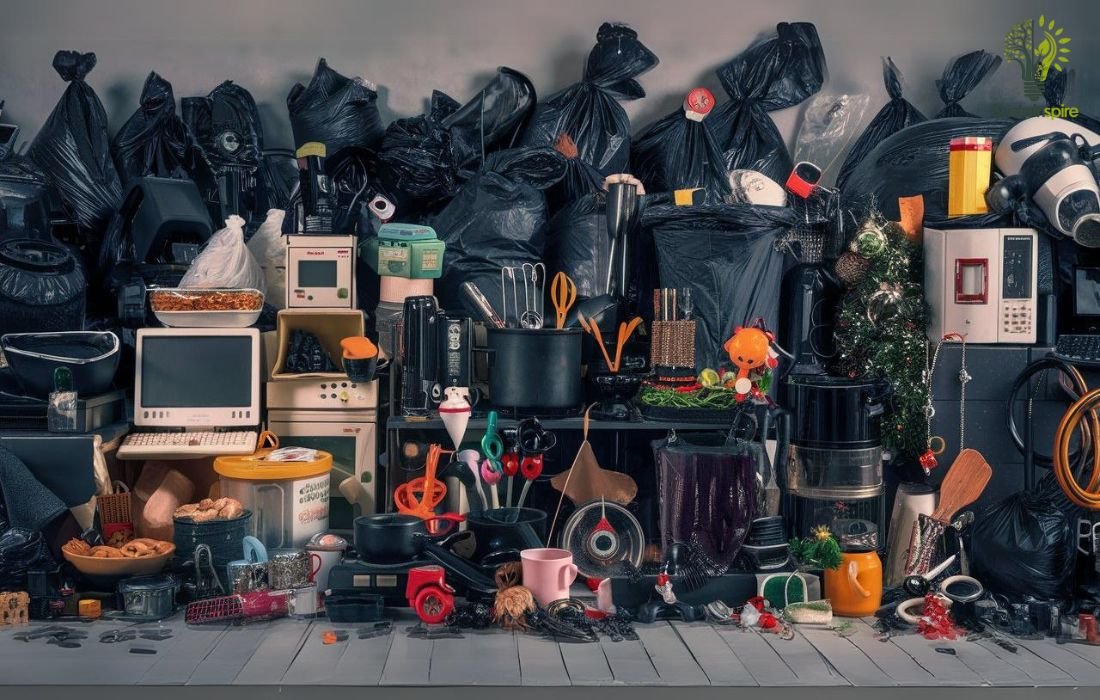Imagine a world where the sky is clear and the air is fresh. The thought alone is refreshing, isn’t it? But what if we told you that this vision is slipping away right before our eyes? Yes, it is true that air pollution is taking its ugly toll on our planet, leading to a host of environmental and health concerns. But what exactly is air pollution? Here we will learn about the which type of pollution includes CFCs and Smog?
Air pollution is a major environmental health risk, causing an estimated 7 million premature deaths each year. It can irritate our lungs, heart, and other organs, and it can even lead to cancer. There are many different types of air pollution, but two of the most common are CFCs and smog.
In this article, we will focus on two specific types of pollution: CFCs and Smog. These pollutants have gained notoriety for their adverse effects on the environment and human health. We will dive deeper into what they are, how they are formed, and what we can do to mitigate their impact. Stay tuned as we unravel the mysteries of CFCs and Smog, leaving you better informed and empowered to make a difference in the fight against pollution.
What is Air Pollution?
Air pollution is a major environmental problem that affects the health of millions of people around the world. The World Health Organization (WHO) defines air pollution as:
“The presence in the outdoor atmosphere of one or more contaminants or pollutants in quantities and duration that are or may be harmful to human health or welfare, or that interfere with the full enjoyment of life or property.”
Air pollution can be caused by a variety of sources, both natural and man-made. Natural sources of air pollution include volcanoes, forest fires, and dust storms. Man-made sources of air pollution include the burning of fossil fuels, industrial processes, and agricultural activities.
The Different Types of Air Pollution – Which type of pollution includes CFCs and Smog?
The different types of air pollution can be classified according to their physical state, chemical composition, and sources.
- Particulate matter (PM) is a type of air pollution that consists of small particles of solid or liquid matter suspended in the air. PM can be emitted from a variety of sources, including the burning of fossil fuels, industrial processes, and agricultural activities. PM can be harmful to human health, as it can cause respiratory problems such as asthma and bronchitis.

- Gaseous pollutants are a type of air pollution that consists of gases such as sulfur dioxide, nitrogen dioxide, and carbon monoxide. Gaseous pollutants can be emitted from a variety of sources, including the burning of fossil fuels, industrial processes, and agricultural activities. Gaseous pollutants can be harmful to human health, as they can cause respiratory problems such as asthma and bronchitis, and they can also contribute to the formation of smog.

- Toxic air pollutants (TAPs) are a type of air pollution that consists of chemicals that are known or suspected to cause cancer or other serious health problems. TAPs can be emitted from a variety of sources, including industrial processes, chemical manufacturing, and hazardous waste disposal. TAPs can be harmful to human health, as they can cause cancer, birth defects, and other serious health problems.

The Effects of Air Pollution on Human Health and the Environment:
Air pollution poses significant threats to both human health and the environment, with far-reaching consequences. The adverse effects of air pollution on human health are well-documented, affecting various organs and systems. Exposure to air pollutants, such as particulate matter, ozone, and nitrogen dioxide, can lead to respiratory issues like asthma and bronchitis.
Particulate matter, consisting of fine particles suspended in the air, can penetrate deep into the lungs, causing inflammation and cardiovascular problems. Ozone, a component of smog, can damage lung tissue and interfere with respiratory function. Nitrogen dioxide can also trigger respiratory symptoms, particularly in individuals with asthma or other lung conditions.
Furthermore, air pollution has detrimental effects on the environment. It contributes to the formation of acid rain, which damages forests, lakes, and other ecosystems. Air pollutants can also disrupt plant growth and reduce crop yields, posing a threat to food security. The negative impacts of air pollution extend beyond human health and the environment, affecting the economy and overall well-being of communities. In the next sections we will learn about the which type of pollution includes CFCs and Smog?
What are CFCs and How CFCs are Used?
CFCs, or chlorofluorocarbons, are synthetic chemicals that were once widely used in a variety of industrial and consumer products, including refrigerators, air conditioners, and aerosol sprays. These chemicals are extremely stable and have a long atmospheric lifetime, making them particularly harmful to the environment.
CFCs were primarily used as refrigerants in cooling systems due to their non-flammability, low toxicity, and high efficiency. They were also employed as blowing agents in the production of foam products, such as insulation and packaging materials. Additionally, CFCs were commonly found in aerosol propellants, cleaning solvents, and fire extinguishers.
The Impact of CFCs on the Ozone Layer
The release of CFCs into the atmosphere has had a devastating impact on the Earth’s ozone layer, which protects life on Earth from harmful ultraviolet radiation. CFCs undergo a series of chemical reactions in the stratosphere, releasing chlorine atoms that destroy ozone molecules. This depletion of the ozone layer has resulted in an increase in UV radiation reaching the Earth’s surface, leading to increased rates of skin cancer, cataracts, and immune system suppression.
In 1987, the Montreal Protocol was signed by countries around the world to phase out the production and consumption of CFCs. This treaty has been largely successful, and the levels of CFCs in the atmosphere have declined significantly. However, the effects of CFCs on the ozone layer will continue to be felt for decades to come.
What is Smog and which type of pollution includes CFCs and Smog?
Smog, a persistent and harmful air pollutant, is a visible sign of poor air quality. It’s a combination of harmful gases and fine particles that can have detrimental effects on our health and environment. Smog, short for “smoke fog,” is a type of air pollution that forms when certain gases react with sunlight and oxygen.
Smog is a type of air pollution that is caused by the reaction of sunlight with pollutants in the air. These pollutants can come from a variety of sources, including cars, trucks, factories, and power plants. These gases include nitrogen oxides (NOx), emitted by vehicles and industries, and volatile organic compounds (VOCs), released from paints, solvents, and other sources. Smog is a major health problem, and it can cause respiratory problems, heart disease, and even cancer.
How CFCs Contribute to Smog Formation
One of the ways that CFCs contribute to smog formation is by reacting with hydroxyl radicals. Hydroxyl radicals are a type of free radical that is involved in many atmospheric reactions, including the formation of smog. When CFCs react with hydroxyl radicals, they produce chlorine atoms. Chlorine atoms can then react with other molecules in the atmosphere to form ozone, which is a major component of smog.
In addition to reacting with hydroxyl radicals, CFCs can also contribute to smog formation by increasing the amount of methane in the atmosphere. Methane is a greenhouse gas that can be broken down by hydroxyl radicals. However, when CFCs are present in the atmosphere, they can react with hydroxyl radicals and prevent them from breaking down methane. This can lead to an increase in the amount of methane in the atmosphere, which can then contribute to smog formation.
The EPA’s Role in Air Pollution Regulation
The Environmental Protection Agency (EPA) is the federal agency responsible for regulating air pollution in the United States. The EPA sets standards for air quality and enforces those standards through a variety of programs. In this year of 2024, we are facing a lot of issues related to these air pollutants. This was the reason we are discussing which type of pollution includes CFCs and Smog.
The EPA also has a program to regulate hazardous air pollutants (HAPs). HAPs are pollutants that are known or suspected to cause cancer or other serious health problems. The EPA regulates HAPs through a variety of programs, including the National Emissions Standards for Hazardous Air Pollutants (NESHAPs).
One of the key responsibilities of the EPA is to monitor and regulate outdoor air quality. The agency has established the Air Quality Index (AQI), which is a color-coded system that measures the concentration of certain air pollutants in the atmosphere. The AQI helps individuals understand the current air quality and make informed decisions about their exposure.
The EPA’s regulations on air pollution are based on scientific research and are designed to protect public health. The agency considers various factors, including the health effects of air pollutants, economic costs, and technological feasibility when developing its regulations. One of the most important program of EPA is the National Ambient Air Quality Standards (NAAQS). The NAAQS are a set of limits on the concentrations of certain pollutants in the air. The EPA sets NAAQS for six pollutants: particulate matter, ozone, carbon monoxide, nitrogen dioxide, sulfur dioxide, and lead.
How Smog Affects EPA Measurements
Smog is typically characterized by a hazy appearance and a pungent odor. Smog can significantly impact air quality and can pose a health risk to individuals. The EPA monitors smog levels and includes them in its AQI measurements. The agency uses a variety of techniques, including air pollution monitors and satellite imagery, to track smog formation and movement.
Smog can also affect the EPA’s measurements of air pollution. When smog is present, it can make it difficult to measure the concentrations of pollutants in the air. This can lead to the EPA underestimating the levels of air pollution in an area.
Mitigating CFCs and Smog Pollution: A Multifaceted Approach
Mitigating the issue of CFCs and smog pollution necessitates a multifaceted strategy to effectively address the contributing factors and ensure a healthier environment. The following measures play a crucial role in this effort:
Reducing CFC Use:
Chlorofluorocarbons (CFCs) are ozone-depleting substances contributing to the greenhouse effect. Eliminating their use in various industrial and commercial applications is a key step in reducing their harmful impact on the environment.
Controlling Smog Formation:
Smog is primarily caused by the reaction of nitrogen oxides (NOx) and volatile organic compounds (VOCs) in the presence of sunlight. Implementing strict regulations on industrial emissions, promoting cleaner combustion technologies, and encouraging the use of public transportation can significantly curb the formation of smog.
Implementing Clean Air Technologies:
Advanced technologies, such as catalytic converters, electrostatic precipitators, and flue gas desulfurization systems, play a vital role in removing pollutants from the air. By retrofitting existing sources with these technologies and promoting their widespread adoption, the emission of harmful compounds can be significantly reduced, improving air quality.
By adopting a comprehensive approach that encompasses these vital measures, we can make significant progress toward mitigating the harmful effects of CFCs and smog pollution, creating a cleaner and healthier environment for present and future generations.
Conclusion:
In the area of environmental concerns, air pollution stands as a challenging threat to human health and the integrity of our planet. Among the various types of air pollution, CFCs (chlorofluorocarbons) and smog hold particular significance.
This article delved into the complexities of CFCs, their impact on the ozone layer, and their role in smog formation. Similarly, we examined smog, its causes, and the health hazards it poses. Throughout our exploration, we emphasized the crucial role played by the EPA in regulating air quality and mitigating pollution.
In conclusion, understanding the nature and effects of CFCs and smog is key in formulating effective strategies to combat air pollution. By implementing measures such as phasing out CFC use, controlling smog formation, and adopting clean air technologies, we can significantly improve air quality and safeguard the health of both humans and the environment. Remember, every breath of fresh air we take is a sign to the importance of protecting our planet from the harmful consequences of pollution. It’s time we all join forces to create a future where clean air is not an exception but a fundamental right.







One thought on “Find out Which Type of Pollution Includes CFCs and Smog”